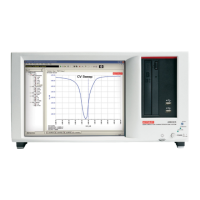4200-900-01 Rev. K / February 2017 Return to Section Topics 3-109
Model 4200-SCS User’s Manual Section 3: Common Device Characterization Tests
Pulse waveforms for NVM testing
A pulse card has several attributes that support NVM testing. To perform the
multi-level pulse waveforms for the typical program / erase waveform (see Figure
3-88), each pulse card channel has the Segment ARB capability.
For more information about Segment ARB
®
waveforms refer to the Segment ARB
waveforms. The ability to disconnect, or float, a particular device pin, within the
Segment ARB waveform requires an inline solid state relay. This solid state relay
is called the high endurance output relay (HEOR).
The pulse card output channels each have 50 Ω output impedance. When current
flows through the pulse channel, there is a voltage drop across this 50 Ω resistor
internal to the pulse card. This dictates that the voltage at the output may be
different from what is expected based on the resistance of the DUT. This effect is
called the Load Line Effect and is covered in more detail in Reference manual,
DUT resistance determines pulse voltage across DUT, page 11-15.
• The gate of a flash or NVM device is high impedance.
• The voltage at the gate will be double of the programmed voltage.
• The voltage at the drain will be a function of the resistance of the drain-source.
Adjusting the pulse level to match the desired drain voltage is performed
iteratively with an oscilloscope to measure V
D
during the pulse.
The projects in the Flash package use two methods to define the multi-level
waveforms used in flash memory testing (for example, Figure 3-88). For
endurance or disturb testing, which uses the subsite stress / measure looping
feature of KITE, the KPulse application is used to define each unique voltage
waveform. Refer to How to Generate Basic Pulses, page 5-1.
Use Kpulse to define and export each unique waveform. The following procedure
details how to create and export a hypothetical program/erase waveform.
Using Kpulse to create and export Segment ARB waveforms
NOTE Each segment pulse waveform must have the same total time. The minimum
programmed time for any segment is 20 ns (20 E-9), but actual output waveform
performance is determined by the channel output capability.
To use Kpulse to create and export Segment ARB waveforms:
1. Close KITE and KCON, if open.
2. Open Kpulse.
3. Load the Kpulse setup file Kpulse_Flash_Example_01.kps. Click File > Load Setup,
then double-click Kpulse_Flash_Example_01.kps. If this file is not available, see Tab l e
3-28 and enter the values into the Segment ARB definition tables in Kpulse. Kpulse should
look similar to Figure 3-92. See Segment ARB waveforms for details on using KPulse.
a. You can use the keyboard copy (Ctrl-c) and paste (Ctrl-v) to copy the Segment ARB
values between channels. This is useful for ensuring that each waveform has the same
period (total waveform time).
b. To select cells for copying, first move the entry cell to row 1 and Start (V).

